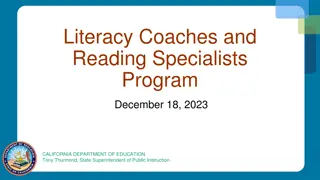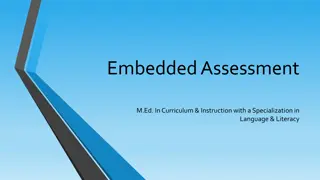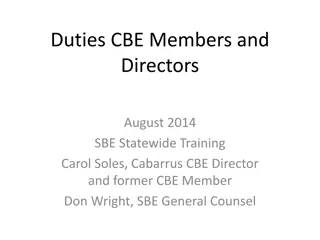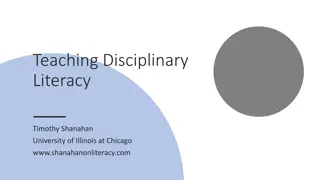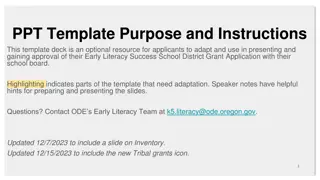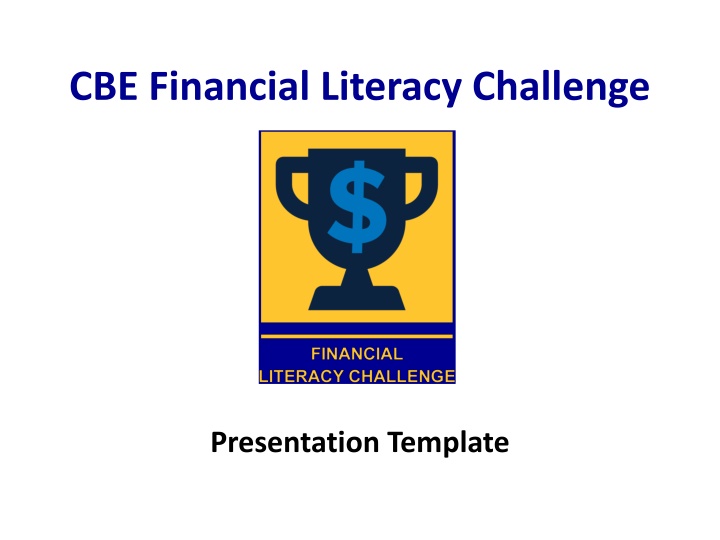
Financial Literacy Challenge Presentation: Plan, Goals, Compensation & Budget
Explore templates and guidance on financial planning, setting goals, expected compensation, and creating a monthly budget. Learn about investment strategies, asset allocation, savings milestones, and sources of salary information. Calculate take-home pay, budget percentages, and debt service assumptions for a well-rounded financial approach.
Download Presentation

Please find below an Image/Link to download the presentation.
The content on the website is provided AS IS for your information and personal use only. It may not be sold, licensed, or shared on other websites without obtaining consent from the author. If you encounter any issues during the download, it is possible that the publisher has removed the file from their server.
You are allowed to download the files provided on this website for personal or commercial use, subject to the condition that they are used lawfully. All files are the property of their respective owners.
The content on the website is provided AS IS for your information and personal use only. It may not be sold, licensed, or shared on other websites without obtaining consent from the author.
E N D
Presentation Transcript
CBE Financial Literacy Challenge Presentation Template
My Financial Plan My Financial Goals Expected Compensation Take Home Pay Calculation Monthly Budget Investment Philosophy Investment Plan Asset Allocation Funds That I Am Choosing Economic Outlook
My Financial Goals What do you want to accomplish? Have an emergency fund of 3-6 months? Pay off student debt? Make 2-3 extra payments a year; pay off in 5 years Save for retirement? Down payment on a house? How much do you want to invest every year? 401K & Roth IRA How much do you want to have in retirement savings in 5, 10, 15 years. Children s college savings plan? 529 Plan
Expected Compensation Tell us what job you think you will obtain. What are the salary ranges? What types of raises should you expect.
Source of Compensation Data Examples from sources of salary information Glassdoor, Payscale, Salary.Com, Indeed, SalaryList, SalaryExpert, Bureau of Labor Statistics I would go to three sites Show their logos and a salary number next to it. Show annual and monthly numbers
Take Home Pay Calculation Show the judges that you know what taxes that you will pay based on where you will be living. Federal Local State FICA( Social Security & Medicare) https://smartasset.com/taxes/paycheck-calculator https://www.adp.com/resources/tools/calculators.aspx Show judges where you got the information and the exact calculation Annual & Monthly
Monthly Budget Assumptions Spend no more than 30% of take home on housing Spend no more than $300 on food Save 10% of take home Debt service no more than 20% of take home Student debt & credit cards Economize on breakfast, lunch, dinner & transportation
Monthly Budget Insert the monthly budget template found on CBE Financial Literacy Challenge Web page. https://sites.allegheny.edu/econ/center-for- business-and-economics/financial-literacy- challenge/
Source of Budget Estimate Tell the judges where you got your information http://money.com/money/4214521/average- americans-annual-budget-college-grad/ https://spendsmart.extension.iastate.edu/plan/what- you-spend/ https://lifehacker.com/how-do-i-figure-out-my- monthly-food-budget-5887545 https://www.myfirstapartment.com/2015/09/rent- calculator/ www.zillow.com https://www.apartmentlist.com/rent-calculator/
Investment Philosophy What percentage of your salary do you want to save? What are you long-term objectives What is your attitude about fees How much risk do you want to have, i.e. all stocks or a mix of stocks and bonds
Investment Plan What are the expected returns of stocks versus bonds You want to be more invested in stocks than bonds because stock returns are higher. You need to and can take risk because you have a long time horizon. Tell us the philosophy you wish to employ, such as: Passive management, i.e. index funds only % of fixed income matches by age Want to buy individual stocks Want to use a target-date approach Want to buy index funds or mutual funds in different sectors Want a mix of mostly index funds and a few stocks
Asset Allocation Using a pie chart, tell us your asset allocation also known as you mix of stocks and bonds Will you use a plain vanilla approach? 80% US stock index funds and 20% bond funds Will the stock portion of you plan be 80% stock mutual funds of which you will divide up into for example us index funds, international index funds, growth stock funds, etc. Take your monthly or annual savings and divide it by the asset allocation. Example: Monthly savings of $1,200; Asset allocation of 35% index funds; 35% growth funds; 10% international funds; 20% bond funds $1,200 x .35 = $420 each month in index funds $1,200 x .35 = $420 each month in growth funds $1,200 x .10 = $120 each month in international funds $1,200 x .20 = $240 each month in a bond funds
Funds That I Am Choosing Google the types of funds you want to buy, such as index funds; growth funds; large cap, mid cap and small cap funds; international funds; sector funds (tech, healthcare, etc.); emerging market funds; or real estate funds (REITS). Pick the ones that you want. List the mutual funds or stocks or a mix of the two and why you are buying them. List the bond funds that you will buy. Include the name of the fund and the ticker symbol of the fund.
Fund Profile # 1 In what type of assets does the fund invest? What are the investment fees for buying into the fund? What is the track record of the fund? How much of your asset allocation will you devote to the fund?
Fund Profile # 2 In what type of assets does the fund invest? What are the investment fees for buying into the fund? What is the track record of the fund? How much of your asset allocation will you devote to the fund?
Fund Profile # 3 In what type of assets does the fund invest? What are the investment fees for buying into the fund? What is the track record of the fund? How much of your asset allocation will you devote to the fund?
Economic Outlook Current GDP versus historical. https://www.bea.gov/data/gdp/gross-domestic-product Current unemployment versus historical. www.bls.gov Current inflation versus historical. https://www.bls.gov/cpi/ What is the Fed saying about its economic outlook? What are the ISM/PMI numbers telling us? https://tradingeconomics.com/united-states/manufacturing-pmi https://www.instituteforsupplymanagement.org/ISMReport/MfgROB. cfm?SSO=1 What is the yield curve telling us? https://www.treasury.gov/resource-center/data-chart-center/interest- rates/pages/textview.aspx?data=yield
Is Now A Good Time To Buy or Should We Hold What are the current levels of the major indecies versus historical S&P 500 (Current P/E Versus Long-Term P/E) Dow Jones Industrial (Current P/E Versus Long-Term P/E) NASDAQ (Current P/E Versus Long-Term P/E) MSCIA EAFE (Current P/E Versus Long-Term P/E) FTSE (Current P/E Versus Long-Term P/E) Hang Seng (Current P/E Versus Long-Term P/E) The market is at record levels, so now might not be the time. Discuss reversion to the mean Will the market revert to the historical average?
Tips For A Great Presentation Make the slides attractive Use graphics if you can Write a script and put it in the notes section Use a binder that you can rest on the podium One team member advances slides while the other talks No smaller than 30 point type Divide your talk presenters by team members if you are more than one person Team member 1 does salary & budget Team member 2 does investment overall plan and philosophy Team member 3 explains what funds you chose Team member 4 does economic outlook Rehearse you presentation at least 5 preferrable 10 times.


